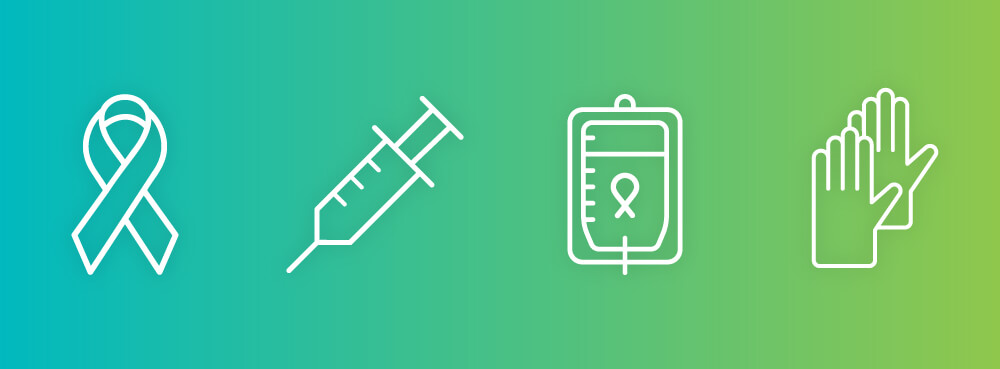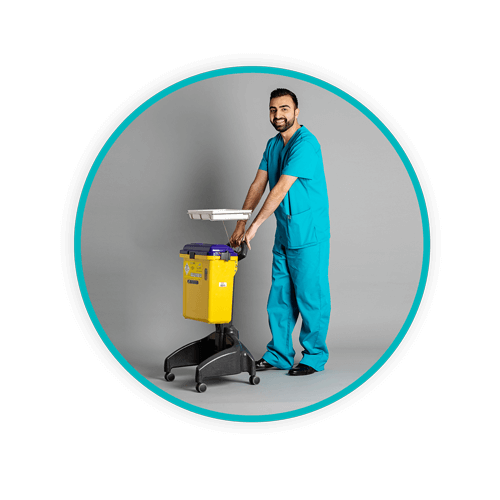How Should Cytotoxic Waste be Disposed of?

Proper disposal of cytotoxic waste is essential not only for safety, but in order to maintain compliance with governmental regulations. Failure to do so can result in costly fines and penalties, as well as damage to reputation. Therefore, specific guidelines are provided for the handling, storage, and disposal of such wastes.
TOPICS WE WILL COVER:
1 / What is a cytotoxic medicine?
2 / Handling and storage of cytotoxic waste
6 / Turn to Sharpsmart for compliance
What is a cytotoxic medicine?
The first step in the waste disposal process is to properly identify cytotoxic medicine or waste. The Health and Safety Executive defines cytotoxic waste as a product that contains any one or more hazardous properties that are carcinogenic, mutagenic, toxic, or toxic for reproduction.
It’s also important to differentiate between a cytotoxic and a cytostatic drug. The terms are often misconstrued. A cytotoxic drug or medicine is toxic to cells, while a cytostatic medicine inhibits cellular division and growth. In healthcare, cytotoxic medicines are also called antineoplastics and are commonly used in chemotherapy treatments. Cytotoxic and cytostatic drugs and their associated waste are managed and treated in the same way. They do not need to be stored segregated prior to disposal.
Unfortunately, cytotoxic medicines are not yet capable of targeting specific mutated cells, but can affect other areas of the body that are not being treated, which may cause a number of side effects to a patient undergoing chemotherapy treatments. Cytotoxic drugs are used in hospitals, research institutes, veterinary clinics, cancer centres, hospices, and even care homes, depending on the scenario.
An important resource in determining if particular medicines contain hazardous properties that pose a risk to health can be found in the document published by the Health and Safety Executive titled “Control of Substances Hazardous to Health”. At the end of the document, Schedule One provides a list of some substances that may be deemed carcinogenic. The document also includes information regarding biological agents and their classification, including those that can cause human disease or prove hazardous to healthcare workers.
Another excellent resource for listings of cytotoxic drugs is the Health Technical Memorandum 07-01 (Safe Management of Healthcare Waste). Specific guidelines are provided regarding segregation, labelling, and disposal.
Handling and storage of cytotoxic waste
Cytotoxic drugs and medicines are classified as hazardous, as are any items, tools, or clothing, PPE, and so forth that have been contaminated with cytotoxic waste in both human and animal healthcare.
It is the duty of care of any cytotoxic waste producer to ensure that employees are trained and have sound knowledge regarding the segregation, handling, storage and disposal processes for such wastes.
Proper colour-coding and segregation of this type of waste is essential. Non-sharps cytotoxic medicinal waste is to be disposed of in the yellow and purple-coloured waste bags, while any cytotoxic medicine can be disposed of in a rigid yellow container with a purple lid. Any sharps waste that has come into contact with a cytotoxic drug should also be segregated in a purple-lidded sharps container.
Cytotoxic waste can be transported off-site by certified waste transporters and then disposed of at a permitted treatment facility. While the colour-coding prescribed in HTM 07:01 is not mandatory, adherence to it ensures a producer complies with the legal requirement in England that prohibit mixing waste streams. Refer to the Health Technical Memorandum for more detailed information.
Labelling considerations
The purpose of specific labelling of medical waste streams not only provides enhanced identification of where specific wastes belong in regard to disposal, but also ensures that proper protocols for the handling of such waste streams are easily identifiable by healthcare providers or any other person handling that waste.
Container labelling must comply with the legal requirements for packaging and transporting waste. As such, labels must identify (among other information):
- The type of waste
- The producer of the waste in cases where a large facility disposes of waste, specific departmental identification is required.
It is essential that any facility that produces cytotoxic waste ensure that appropriate containers and receptacles are available.
Cytotoxic waste disposal
Any facility that generates cytotoxic waste must have definitive procedures for the safe disposal of that waste. It’s important for healthcare professionals to be aware that the bedding or gowns of a patient who has undergone cytotoxic treatments, as well as any feminine hygiene waste, may also be contaminated with active metabolites (such as from sweat or body fluids) of those cytotoxic drugs and as such, should also be treated as cytotoxic waste. All purple stream waste is deemed hazardous waste and is subject to the guidelines of the hazardous/special waste regulations. (See Chapter 5 of the Health Technical Memorandum: Waste minimisation, segregation, colour-coding and storage).
Hazardous waste must be accompanied by a hazardous waste consignment note until it reaches its final disposal location, a high temperature incinerator. As well as other pertinent information, the consignment note must document the EWC code and hazardous property codes of the waste. Cytotoxic waste produced in human healthcare should be transported under 18 01 08 whilst animal related cytotoxic waste is classed under 18 02 07. A cytotoxic drug may have more than one hazard property:
- Toxic – HP6
- Carcinogenic – HP7
- Toxic for reproduction – HP10
-
Mutagenic – HP11
The waste may also have other hazardous properties, for example HP9 – Infectious. It is the duty of care of the waste producer to ensure they are all documented and that these guidelines are met.
Maintaining compliance
Management of compliance requires a number of steps and processes that range from creation of a waste policy to regular auditing, adequate training, and appropriate documentation in all facilities that produce cytotoxic and/or cytotoxic waste as well as other waste streams.
Appropriate training enhances not only performance improvement but ensures the safety of healthcare providers handling cytotoxic waste. Training also ensures that waste carriers that transport such waste off-site for disposal also follow guidelines.

Turn to Sharpsmart for guidance
With experience in healthcare waste segregation streams and their packaging, labelling, and colour-coding requirements, turn to Sharpsmart. We develop compliant containers for numerous waste streams including cytotoxic waste, and are knowledgeable in not only compliant placement of such containers, but how they are to be disposed of. For additional resources, products, and guidance in regard to cytotoxic waste and disposal management, contact one of our knowledgeable representatives today.
